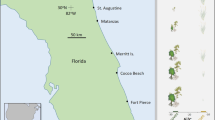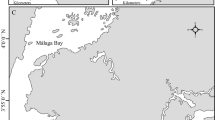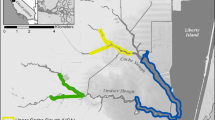Abstract
We measured the effects of a plant invasion (Phragmites australis) on resident fish (Fundulus heteroclitus) in New England salt marshes by assessing diet quality at the food web base and by quantifying the importance of primary producers to secondary production using a recently developed Bayesian mixing model (Stable Isotope Analysis in R, “SIAR”). Spartina alterniflora, the dominant native plant, exhibited significantly greater leaf toughness and higher C/N ratios relative to P. australis. Benthic microalgae and phytoplankton (as suspended particulate matter) exhibited the lowest C/N indicating higher diet quality. We conducted a sensitivity analysis in SIAR by modeling F. heteroclitus at three separate trophic levels (1.5, 2.0, and 2.5) using species-specific discrimination factors to determine basal resource contributions. Overall, the best-fitting models include those that assume F. heteroclitus resides approximately 2.0 trophic levels above primary producers. Using discrimination factors from a range of data sources reported in the literature, our analyses revealed that consumers rely less on benthic microalgae and phytoplankton in restricted marshes (7–23 % and 11–44 %, respectively) relative to reference marshes (5–34 % and 23–48 %, respectively), resulting in a shift in diet toward invasive plant consumption (0–27 %). This is likely due to increased P. australis cover and marsh surface shading leading to decreased microalgal biomass, combined with reduced flooding of the marsh surface that favors terrestrial invertebrate assemblages. Restoration decreased the quantity of P. australis in the food web (0–15 %) and increased the importance of microalgae (1–30 %), phytoplankton (19–48 %), and native plants (23–63 %), indicating a shift in ecological recovery toward reference conditions.




Similar content being viewed by others
References
Able, K.W., S.M. Hagan, and S.A. Brown. 2003. Mechanisms of marsh habitat alteration due to Phragmites: response of young-of-the-year mummichog (Fundulus heteroclitus) to treatment for Phragmites removal. Estuaries 26(2B): 484–494.
Able, K.W., S.M. Hagan, and S.A. Brown. 2006. Habitat use, movement, and growth of young-of-the-year Fundulus spp. in southern New Jersey salt marshes: comparisons based on tag/recapture. Journal of Experimental Marine Biology and Ecology 335(2006): 177–187.
Able, K.W., S.M. Hagan, K. Kovitvongsa, S.A. Brown, and J.C. Lamonaca. 2007. Piscivory by the mummichog (Fundulus heteroclitus): evidence from the laboratory and salt marshes. Journal of Experimental Marine Biology and Ecology 345(2007): 26–37.
Adamowicz, S.C., and K. O’Brien. 2012. Drakes Island tidal restoration: science, community, and compromise. In Tidal marsh restoration: a synthesis of science and management, ed. C. Roman and D. Burdick. Washington, DC: Island.
Allen, E.A., P.E. Fell, M.A. Peck, J.A. Gieg, C.R. Guthke, and M.D. Newkirk. 1994. Gut contents of common mummichogs, Fundulus heteroclitus L., in a restored impounded marsh and in natural reference marshes. Estuaries 17(2): 462–471.
Beck, M.W., K.L. Heck Jr., K.W. Able, D.L. Childers, D.B. Eggleston, B.M. Gillanders, et al. 2001. The identification, conservation, and management of estuarine and marine nurseries for fish and invertebrates. Bioscience 52(8): 633–641.
Bond, A.L., and A.W. Diamond. 2011. Recent Bayesian stable-isotope mixing models are highly sensitive to variation in discrimination factors. Ecological Applications 21(4): 1017–1023.
Brittain, R.A., A. Schimmelmann, D.F. Parkhurst, and C.B. Craft. 2012. Habitat use by coastal birds inferred from stable carbon and nitrogen isotopes. Estuaries and Coasts 35: 633–645.
Bushaw-Newton, K.L., D.A. Kreeger, S. Doaty, and D.J. Velinsky. 2008. Utilization of Spartina- and Phragmites-derived dissolved organic matter by bacteria and ribbed mussels (Geukensia demissa) from Delaware Bay salt marshes. Estuaries and Coasts 31: 694–703.
Callaway, R.M., and W.M. Ridenour. 2004. Novel weapons: invasive success and the evolution of increased competitive ability. Frontiers in Ecology and the Environment 2(8): 436–443.
Caut, S., E. Angulo, and F. Courchamp. 2009. Variation in discrimination factors (Δ15N and Δ13C): the effect of diet isotopic values and applications for diet reconstruction. Journal of Applied Ecology 46: 443–453.
Chambers, R.M., L.A. Meyerson, and K. Saltonstall. 1999. Expansion of Phragmites australis into tidal wetlands of North America. Aquatic Botany 64: 261–273.
Chanton, J.P., and F.G. Lewis. 1999. Plankton and dissolved inorganic carbon isotopic composition in a river-dominated estuary: Apalachicola Bay, Florida. Estuaries 22(3A): 575–583.
Childers, D.L., J.W. Day Jr., and H.N. McKellar Jr. 2000. Twenty more years of marsh and estuarine flux studies: revisiting Nixon (1980). In Concepts and controversies in tidal marsh ecology, ed. M.P. Weinstein and D.A. Kreeger, 391–424. Dordrecht: Kluwer.
Cloern, J.E., E.A. Canuel, and D. Harris. 2002. Stable carbon and nitrogen isotope composition of aquatic and terrestrial plants of the San Francisco Bay estuarine system. Limnology and Oceanography 7(3): 713–729.
Couch, C.A. 1989. Carbon and nitrogen stable isotopes of meiobenthos and their food resources. Estuarine, Coastal and Shelf Science 28: 433–441.
Currin, C.A., S.Y. Newell, and H.W. Paerl. 1995. The role of standing dead Spartina alterniflora and benthic microalgae in salt marsh food webs: considerations based on multiple stable isotope analysis. Marine Ecology Progress Series 121: 99–116.
Currin, C.A., S.C. Wainright, K.W. Able, M.P. Weinstein, and C.M. Fuller. 2003. Determination of food web support and trophic position of the mummichog, Fundulus heteroclitus, in New Jersey smooth cordgrass (Spartina alterniflora), common reed (Phragmites australis), and restored salt marshes. Estuaries 26: 495–510.
Darnell, R.M. 1967. Organic detritus in relation to the estuarine ecosystem. In Estuaries, ed. G.H. Lauff, 376–382. AAAS Publication 83, Washington, D.C.
Deegan, L.A., J.L. Bowen, D. Drake, J.W. Fleeger, C.T. Friedrichs, K.A. Galván, et al. 2007. Susceptibility of salt marshes to nutrient enrichment and predator removal. Ecological Applications 17(5): S42–S63.
Deegan, L.A., and R.H. Garritt. 1997. Evidence for spatial variability in estuarine food webs. Marine Ecology Progress Series 147: 31–47.
Deegan, L.A., J.E. Hughes, and R.A. Rountree. 2000. Salt marsh ecosystem support of marine transient species. In Concepts and controversies in tidal marsh ecology, ed. M.P. Weinstein and D.A. Kreeger, 333–368. Dordrecht: Kluwer.
Dennis, C.A., M.A. MacNeil, J.Y. Rosati, T.E. Pitcher, and A.T. Fisk. 2010. Diet discrimination factors are inversely related to δ15N and δ13C values of food for fish under controlled conditions. Rapid Communications in Mass Spectrometry 24: 3515–3520.
Dibble, K.L., and L.A. Meyerson. 2012. Tidal flushing restores the physiological condition of fish residing in degraded salt marshes. PLoS One 7(9): e46161. doi:10.1371/journal.pone.0046161.
Dobush, G.R., C.D. Ankney, and D.G. Krementz. 1985. The effect of apparatus, extraction time, and solvent type on lipid extractions of snow geese. Canadian Journal of Zoology 63: 1917–1920.
Doucette, J.L., B. Wissel, and C.M. Somers. 2011. Cormorant–fisheries conflicts: stable isotopes reveal a consistent niche for avian piscivores in diverse food webs. Ecological Applications 21(8): 2987–3001.
Eberhardt, A.L., D.M. Burdick, and M. Dionne. 2011. The effects of road culverts on nekton in New England salt marshes: implications for tidal restoration. Restoration Ecology 19(6): 776–785.
Elsdon, T.S., S. Ayvazian, K.W. McMahon, and S.R. Thorrold. 2010. Experimental evaluation of stable isotope fractionation in fish muscle and otoliths. Marine Ecology Progress Series 408: 195–205.
Fritz, E.S., W.H. Meredith, and V.A. Lotrich. 1975. Fall and winter movements and activity level of the mummichog, Fundulus heteroclitus, in a tidal creek. Chesapeake Science 16(3): 211–215.
Fry, B. 1988. Food web structure on Georges Bank from stable C, N, and S isotopic compositions. Limnology and Oceanography 33(5): 1182–1190.
Fry, B. 2002. Conservative mixing of stable isotopes across estuarine salinity gradients: a conceptual framework for monitoring watershed influences on downstream fisheries production. Estuaries 25(2): 264–271.
Fry, B., M. Cieri, J. Hughes, C. Tobias, L.A. Deegan, and B. Peterson. 2008. Stable isotope monitoring of benthic–planktonic coupling using salt marsh fish. Marine Ecology Progress Series 369: 193–204.
Galván, K., J.W. Fleeger, and B. Fry. 2008. Stable isotope addition reveals dietary importance of phytoplankton and microphytobenthos to saltmarsh infauna. Marine Ecology Progress Series 359: 37–49.
Galván, K., J.W. Fleeger, B. Peterson, D. Drake, L.A. Deegan, and D.S. Johnson. 2011. Natural abundance stable isotopes and dual isotope tracer additions help to resolve resources supporting a saltmarsh food web. Journal of Experimental Marine Biology and Ecology 410: 1–11.
Golet, F.C., D.H.A. Myshrall, L.R. Oliver, P.W.C. Paton, and B.C. Tefft. 2012. Role of science and partnerships in salt marsh restoration at the Galilee Bird Sanctuary, Narragansett, Rhode Island. In Tidal marsh restoration: a synthesis of science and management, ed. C. Roman and D. Burdick. Washington, DC: Island.
Gratton, C., and R.F. Denno. 2005. Restoration of arthropod assemblages in a Spartina salt marsh following removal of the invasive plant Phragmites australis. Restoration Ecology 13(2): 358–372.
Gratton, C., and R.F. Denno. 2006. Arthropod food web restoration following removal of an invasive wetland plant. Ecological Applications 16: 622–631.
Grosholz, E. 2010. Avoidance by grazers facilitates spread of an invasive hybrid plant. Ecology Letters 13: 145–153.
Gruber, N., C.D. Keeling, R.B. Bacastow, P.R. Guenther, T.J. Lueker, M. Wahlen, et al. 1999. Spatiotemporal patterns of carbon-13 in the global surface oceans and the oceanic Suess effect. Global Biogeochemical Cycles 13(2): 307–335.
Haines, E.B. 1977. The origins of detritus in Georgia salt marsh estuaries. Oikos 29(2): 254–260.
Hendricks, L.G., H.E. Mossop, and C.E. Kicklighter. 2011. Palatability and chemical defense of Phragmites australis to the marsh periwinkle snail Littoraria irrorata. Journal of Chemical Ecology 37: 838–845.
Jackson, A.L., R. Inger, S. Bearhop, and A. Parnell. 2009. Erroneous behavior of MixSIR, a recently published Bayesian isotope mixing model: a discussion of Moore & Semmens (2008). Ecology Letters 12: E1–E5.
Jacob, U., K. Mintenbeck, T. Brey, R. Knust, and K. Beyer. 2005. Stable isotope food web studies: a case for standardized sample treatment. Marine Ecology Progress Series 287: 251–253.
James-Pirri, M.J., K.B. Raposa, and J.G. Catena. 2001. Diet composition of mummichogs, Fundulus heteroclitus, from restoring and unrestricted regions of a New England (U.S.A.) salt marsh. Estuarine, Coastal and Shelf Science 53: 205–213.
Jiménez, J.M., K. Wieski, L.B. Marczak, C.K. Ho, and S.C. Pennings. 2012. Effects of an omnivorous katydid, salinity, and nutrients on a planthopper–Spartina food web. Estuaries and Coasts 35: 475–485.
Kneib, R.T. 1986. The role of Fundulus heteroclitus in salt marsh trophic dynamics. American Zoologist 26(1): 259–269.
Kneib, R.T. 1997. The role of tidal marshes in the ecology of estuarine nekton. Oceanography and Marine Biology: An Annual Review 35: 163–220.
Kneib, R.T. 2003. Bioenergetic and landscape considerations for scaling expectations of nekton production from intertidal marshes. Marine Ecology Progress Series 264: 279–296.
Litvin, S.Y., and M.P. Weinstein. 2003. Life history strategies of estuarine nekton: the role of marsh macrophytes, benthic microalgae, and phytoplankton in the trophic spectrum. Estuaries 26(2B): 552–562.
Litvin, S.Y., and M.P. Weinstein. 2004. Multivariate analysis of stable-isotope ratios to infer movements and utilization of estuarine organic matter by juvenile weakfish (Cynoscion regalis). Canadian Journal of Fisheries and Aquatic Sciences 61: 1851–1861.
Lotrich, V.A. 1975. Summer home range and movements of Fundulus heteroclitus (Pisces: Cyprinodontidae) in a tidal creek. Ecology 56(1): 191–198.
McCutchan Jr., J.H., W.M. Lewis Jr., C. Kendall, and C.C. McCrath. 2003. Variation in trophic shift for stable isotope ratios of carbon, nitrogen, and sulfur. Oikos 102: 378–390.
Meyerson, L.A., Saltonstall, K. & Chambers, R.M. 2009. Phragmites australis in Eastern North America: a historical and ecological perspective. In Salt marshes under global siege, eds. B.R. Silliman, E. Grosholz, & M.D. Bertness, 57–82. Berkeley: University of California Press.
Meyerson, L.A., K. Saltonstall, L. Windham, E. Kiviat, and S. Findlay. 2000. A comparison of Phragmites australis in freshwater and brackish marsh environments in North America. Wetlands Ecology and Management 8: 89–103.
Nixon, S.W. 1980. Between coastal marshes and coastal waters: a review of twenty years of speculation and research on the role of salt marshes in estuarine productivity and water chemistry. In Estuarine and wetland processes, ed. P. Hamilton and K.B. MacDonald, 437–525. New York: Plenum.
O’Brien, D.M., D.P. Schrag, and C. Martínez del Rio. 2000. Allocation to reproduction in a hawkmoth: a quantitative analysis using stable carbon isotopes. Ecology 81(10): 2822–2831.
Odum, E.P. 1968. A research challenge: evaluating the productivity of coastal and estuarine water. Proceedings, 2nd Sea Grant Conference, Graduate School of Oceanography. University of Rhode Island, Kingston, Rhode Island.
Orr, S.P., J.A. Rudgers, and K. Clay. 2005. Invasive plants can inhibit native tree seedlings—testing potential allelopathic mechanisms. Plant Ecology 181: 153–165.
Orson, R.A., Osgood, D.T., Zajac, R.N. & Tait, J.F. 2000. Sybil Creek restoration: baseline data and habitat assessment prior to restoration. Report submitted to the State of Connecticut, Department of Environmental Protection, Office of Long Island Sound Programs. October 2000. Accessed 3 June 2013: http://www.branfordlandtrust.org/sybilcreek/scmain.html
Osgood, D.T., D.J. Yozzo, R.M. Chambers, D. Jacobson, T. Hoffman, et al. 2003. Tidal hydrology and habitat utilization by resident nekton in Phragmites and non-Phragmites marshes. Estuaries 26(2B): 522–533.
Parker, J.D., J.P. Montoya, and M.E. Hay. 2008. A specialist detritivore links Spartina alterniflora to salt marsh food webs. Marine Ecology Progress Series 364: 87–95.
Parnell, A.C., R. Inger, S. Bearhop, and A.L. Jackson. 2010. Source partitioning using stable isotopes: coping with too much variation. PLoS One 5(3): e9672. doi:10.1371/journal.pone.0009672.
Pennings, S.C., T.H. Carefoot, E.L. Siska, M.E. Chase, and T.A. Page. 1998. Feeding preferences of a generalist salt marsh crab: relative importance of multiple plant traits. Ecology 79(6): 1968–1979.
Peterson, B.J. 1999. Stable isotopes as tracers of organic matter input and transfer in benthic food webs: a review. Acta Oecologica 20(4): 479–487.
Peterson, B.J., and B. Fry. 1987. Stable isotopes in ecosystem studies. Annual Review of Ecology and Systematics 18: 293–320.
Pinnegar, J.K., and N.V.C. Polunin. 1999. Differential fractionation of δ13C and δ15N among fish tissues: implications for the study of trophic interactions. Functional Ecology 13: 225–231.
Post, D.M. 2002. Using stable isotopes to estimate trophic position: models, methods, and assumptions. Ecology 83(3): 703–718.
Post, D.M., C.A. Layman, D.A. Arrington, G. Takimoto, J. Quattrochi, and C.G. Montana. 2007. Getting to the fat of the matter: models, methods and assumptions for dealing with lipids in stable isotope analyses. Oecologia 152: 179–189.
Raposa, K.B., and C.T. Roman. 2003. Using gradients in tidal restriction to evaluate nekton community responses to salt marsh restoration. Estuaries 28(1): 98–105.
Roman, C.T., K.B. Raposa, S.C. Adamowicz, M.J. James-Pirri, and J.G. Catena. 2002. Quantifying vegetation and nekton response to tidal restoration of a New England salt marsh. Restoration Ecology 10(3): 450–460.
Rooth, J.E., J. Court Stevenson, and J.C. Cornwell. 2003. Increased sediment accretion rates following invasion by Phragmites australis: the role of litter. Estuaries 26(2B): 475–483.
Rudrappa, T., J. Bonsall, J.L. Gallagher, D.M. Seliskar, and H.P. Bais. 2007. Root-secreted allelochemical in the noxious weed Phragmites australis deploys a reactive oxygen species response and microtubule assembly disruption to execute rhizotoxicity. Journal of Chemical Ecology 33: 1898–1918.
Smith, S.M., C.T. Roman, M.J. James-Pirri, K. Chapman, J. Portnoy, and E. Gwilliam. 2009. Responses of plant communities to incremental hydrologic restoration of a restricted salt marsh in southern New England (Massachusetts, U.S.A.). Restoration Ecology 17(5): 606–618.
Teal, J.M. 1962. Energy flow in the salt marsh ecosystem of Georgia. Ecology 43: 614–624.
Tenore, K.R. 1988. Nitrogen in benthic food chains. In Nitrogen cycling in coastal marine environments, ed. T.H. Blackburn and J. Sorensen, 191–206. New York: Wiley.
Vanderklift, M.A., and S. Ponsard. 2003. Sources of variation in consumer-diet δ15N enrichment: a meta-analysis. Oecologia 136: 169–182.
Wainright, S.C., and B. Fry. 1994. Seasonal variation of the stable isotopic compositions of coastal marine plankton from Woods Hole, Massachusetts and Georges Bank. Estuaries 17(3): 552–560.
Wainright, S.C., M.P. Weinstein, K.W. Able, and C.A. Currin. 2000. Relative importance of benthic microalgae, phytoplankton, and the detritus of smooth cordgrass Spartina alterniflora and the common reed Phragmites australis to brackish-marsh food webs. Marine Ecology Progress Series 200: 77–91.
Warren, R.S., P.E. Fell, R. Rozsa, A.H. Brawley, A.C. Orsted, E.T. Olson, et al. 2002. Salt marsh restoration in Connecticut: 20 years of science and management. Restoration Ecology 10(3): 497–513.
Weidenhamer, J.D., M. Li, J. Allman, R.G. Bergosh, and M. Posner. 2013. Evidence does not support a role for gallic acid in Phragmites australis invasion success. Journal of Chemical Ecology 39: 323–332.
Weinstein, M.P., S.Y. Litvin, K.L. Bosley, C.M. Fuller, and S.C. Wainright. 2000. The role of tidal marsh as an energy source for marine transient and resident finfishes: a stable isotope approach. Transactions of the American Fisheries Society 129: 797–810.
Weinstein, M.P., S.Y. Litvin, and V.G. Guida. 2009. Essential fish habitat and wetland restoration success: a tier III approach to the biochemical condition of common mummichog Fundulus heteroclitus in common reed Phragmites australis and smooth cordgrass Spartina alterniflora-dominated salt marshes. Estuaries and Coasts 32: 1011–1022.
Weis, J.S. 2005. Diet and food web support of the white perch, Morone americana, in the Hackensack Meadowlands of New Jersey. Environmental Biology of Fishes 74: 109–113.
Wozniak, A.S., C.T. Roman, S.C. Wainright, R.A. McKinney, and M.J. James-Pirri. 2006. Monitoring food web changes in tide-restored salt marshes: a carbon stable isotope approach. Estuaries and Coasts 29(4): 568–578.
Wyatt, A.S.J., A.M. Waite, and S. Humphries. 2010. Variability in isotope discrimination factors in coral reef fishes: implications for diet and food web reconstruction. PLoS One 5(10): e13682. doi:10.1371/journal.pone.0013682.
Zedler, J.B. 1980. Algal mat productivity: comparisons in a salt marsh. Estuaries 3(2): 122–131.
Acknowledgments
We thank Rick McKinney at the Environmental Protection Agency (EPA) Atlantic Ecology Laboratory for use of the isotope ratio mass spectrometer, guidance on preparing samples, and for the interpretation of IRMS output. Many thanks to Jim Cronin and Warwick Allen at Louisiana State University for leaf chemistry analysis. The following agencies and organizations provided support to KLD: EPA STAR Graduate Fellowship (FP-91710001-0), National Oceanic and Atmospheric Administration NERR Graduate Fellowship (NA09NOS4200041), National Science Foundation (NSF) IGERT Grant to the Coastal Institute at URI (0504103), Philanthropic Educational Organization (Lellis-Dib3158688), Northeast Aquatic Plant Management Society, Rhode Island Natural History Survey and The Nature Conservancy of Rhode Island (Lellis-Dibble 05-30-09), and the URI Coastal Fellows Program. To LAM: US NSF DEB Award (1049914), URI Agricultural Experiment Station (RI00H-332, 311000-6044), and the U.S. and Czech Fulbright Commissions.
Author information
Authors and Affiliations
Corresponding author
Additional information
Communicated by Scott C. Neubauer
Rights and permissions
About this article
Cite this article
Dibble, K.L., Meyerson, L.A. The Effects of Plant Invasion and Ecosystem Restoration on Energy Flow through Salt Marsh Food Webs. Estuaries and Coasts 37, 339–353 (2014). https://doi.org/10.1007/s12237-013-9673-5
Received:
Revised:
Accepted:
Published:
Issue Date:
DOI: https://doi.org/10.1007/s12237-013-9673-5




